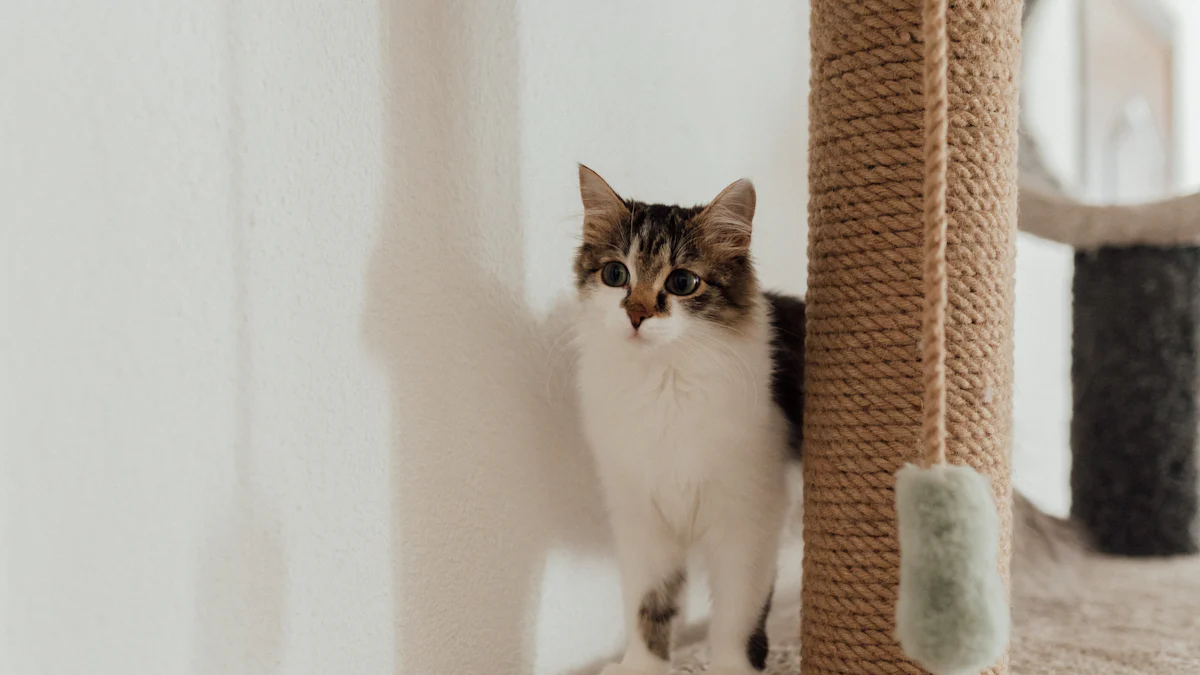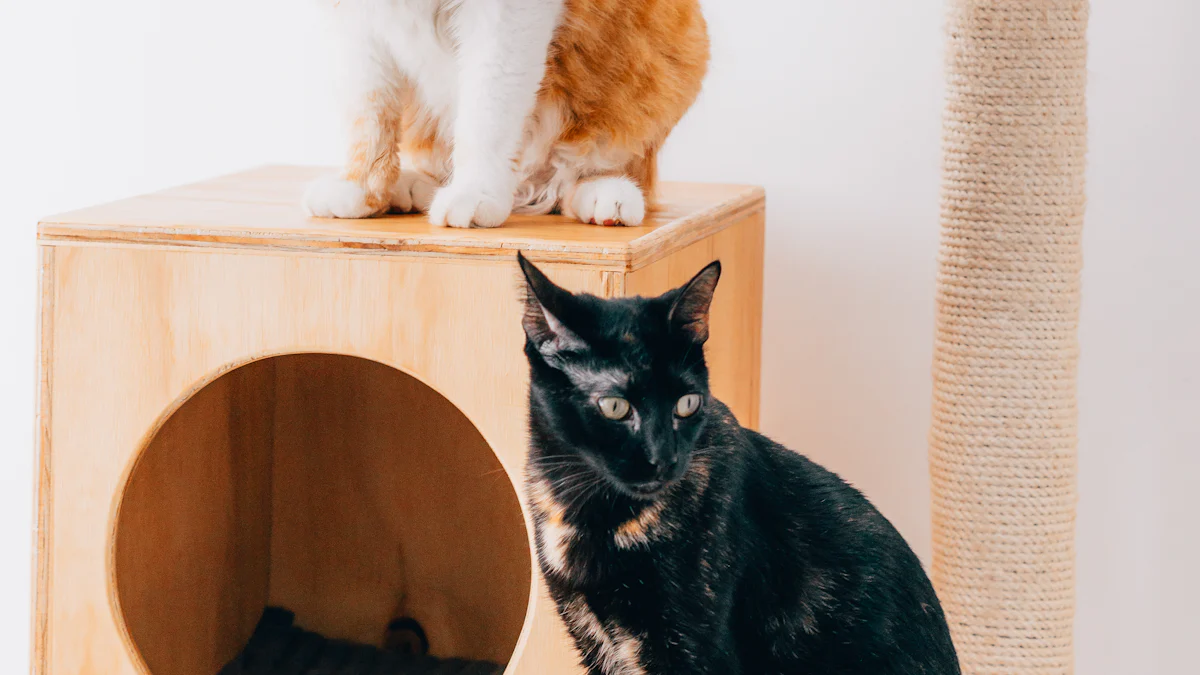Cats are fascinating creatures, aren’t they? They’re independent yet crave connection. A cat scratching post isn’t just a piece of furniture—it’s a gateway to their happiness. Scratching releases endorphins, making your cat feel relaxed and content. Plus, it helps them unwind, reducing stress and keeping destructive habits at bay.
Why Cats Need a Scratching Post
Understanding the Instinct to Scratch
Scratching is more than just a quirky habit—it’s a natural instinct. Your cat scratches to mark its territory, both visually and with scent. Did you know cats have scent glands between their toes? When they scratch, they leave behind a unique scent that makes them feel safe and secure. It’s their way of saying, “This is my space.” Scratching also helps them shed the outer layers of their claws, keeping them sharp and healthy. Without a proper outlet like a cat scratching post, your furniture might become their next target.
Benefits for Physical and Mental Well-Being
Scratching isn’t just good for your cat’s claws—it’s a full-body workout. When your cat stretches and flexes while scratching, it tones their muscles and improves flexibility. This is especially important for indoor cats who don’t get as much physical activity. Beyond the physical perks, scratching is a stress reliever. It releases endorphins, which help your cat feel calm and happy. If your home has multiple pets or frequent changes, scratching can help your cat cope with stress and avoid frustration. A cat scratching post provides the perfect outlet for this essential behavior.
How Scratching Enhances Your Bond
Believe it or not, scratching can bring you and your cat closer. When your cat uses a scratching post near you, it’s a sign of trust and comfort. Cats often scratch in areas associated with their owners, leaving behind both visual and scent marks. This behavior shows affection and a sense of belonging. By encouraging your cat to use a scratching post, you’re creating a shared space where they feel safe and loved. Plus, engaging with your cat during scratching sessions—using toys or treats—can strengthen your bond even further.
Picking the Right Cat Scratching Post
Key Features: Height, Stability, and Material
When choosing a scratching post, you want to focus on three key features: height, stability, and material. Cats love to stretch their bodies fully while scratching, so a taller post is ideal. If it’s too short, your cat might lose interest. Stability is just as important. A wobbly post can scare your cat, making them avoid it altogether. Look for one with a sturdy base that won’t tip over.
Material matters too. Cats prefer surfaces they can easily claw into, like sisal rope, carpet, or cardboard. The texture should feel satisfying but not too hard or flimsy. If your cat loves scratching your furniture, try to match the post’s material to the fabric they’re drawn to. This can help redirect their attention to the post instead of your couch.
Exploring Different Types: Vertical, Horizontal, and Multi-Level
Not all cats scratch the same way. Some prefer vertical posts, while others enjoy horizontal ones. Vertical posts are great for cats who like to stretch upward, while horizontal ones mimic scratching on the ground. Multi-level posts are a fantastic option if you have multiple cats or an active feline. These posts offer various scratching surfaces and textures, catering to different preferences. They also reduce stress by giving each cat their own space to scratch.
Why Investing in Quality Matters
A high-quality scratching post is worth every penny. Durable materials like seagrass, coconut fiber, or tree bark can withstand heavy use and last longer. Seagrass is especially popular because it’s tough and appealing to cats. Coconut fiber and tree bark are eco-friendly options that provide a natural scratching experience. While carpet is soft and comfortable, it tends to wear out faster and can get messy. Investing in a well-made post ensures your cat stays happy and your furniture stays intact.
Where to Place the Scratching Post
Ideal Spots: Near Sleeping Areas and High-Traffic Zones
Placement matters when it comes to your cat’s scratching post. Cats love to scratch in areas where they spend most of their time. Start by placing one near their favorite sleeping spot. Cats often stretch and scratch right after waking up—it’s their way of getting their muscles moving.
High-traffic zones are another great choice. Cats enjoy scratching in socially significant areas, like the living room or hallways. These spots let them mark their territory and feel included in the household. If your cat has a favorite pathway, consider placing a scratching post along it. This makes it easy for them to engage in their natural behavior without wandering too far.
Tip: Observe your cat’s habits to find the perfect location. If they’re scratching furniture in a specific room, that’s a clue to place the post there.
Common Mistakes to Avoid
Avoid hiding the scratching post in a corner or an unused room. Cats won’t use it if it’s out of sight or in a place they rarely visit. Don’t place it too close to their litter box either—cats prefer to keep their scratching and bathroom areas separate.
Another mistake is assuming one post is enough. If you have a multi-cat household, a single post can lead to competition and stress. Each cat needs their own space to scratch and mark territory.
Adding Variety with Multiple Posts
Adding multiple scratching posts can transform your home into a cat-friendly haven. Each post caters to different scratching styles, whether vertical, horizontal, or angled. This variety keeps your cat engaged and prevents boredom.
In homes with more than one cat, multiple posts reduce territorial disputes. Each cat can claim their own scratching area, easing tension and promoting harmony. Distributing posts throughout your home also satisfies their instinct to mark territory in different spaces. A well-placed cat scratching post in every room ensures your feline friends stay happy and stress-free.
Encouraging Your Cat to Use the Scratching Post
Using Catnip, Toys, and Treats
Sometimes, your cat just needs a little extra motivation to explore their scratching post. Catnip can work wonders here. Sprinkle or rub a bit of catnip on the post to make it irresistible. Studies show that cats interact more with scratching posts scented with catnip compared to unscented ones:
|
Condition |
Scratching Interactions |
|---|---|
|
Catnip |
Increased |
|
Unscented |
Decreased |
Toys can also grab your cat’s attention. Posts with dangling balls, feathers, or even hideaways create a playful environment. Interactive scratching toys combine fun and functionality, encouraging your cat to scratch while they play. Treats are another great tool. Reward your cat with a small treat each time they use the post. This positive association makes them more likely to return to it.
Positive Reinforcement Techniques
Cats respond best to rewards, not punishment. When your cat uses the scratching post, praise them with a cheerful voice or offer a treat. This simple act reinforces the behavior you want to see. Operant conditioning, where a reward follows a desired action, is key here.
Tip: If you’re feeling adventurous, try clicker training. Click when your cat scratches the post, then immediately reward them. This method bridges the gap between the action and the reward, making it easier for your cat to understand what you want.
Avoid scolding your cat if they scratch furniture instead. Redirect them to the post and reward them when they use it. Over time, they’ll learn that the post is the better option.
Building a Routine with Patience
Consistency is your best friend when introducing a new habit. Place the scratching post near your cat’s favorite spots, like their bed or a sunny window. Cats often scratch after waking up, so having the post nearby makes it convenient.
Encourage your cat to use the post at the same times each day. For example, you can guide them to it after meals or playtime. Use toys or treats to make these moments fun and engaging.
Remember, patience is key. Some cats take to a scratching post immediately, while others need time to adjust. Stick with it, and celebrate small victories along the way. A little persistence goes a long way in building a routine your cat will love.
Overcoming Challenges with the Scratching Post
Why Punishment is Counterproductive
Punishing your cat for scratching in the wrong place might seem like a quick fix, but it often backfires. Scratching is a natural behavior that helps cats mark their territory and maintain healthy claws. When you punish them, they don’t connect the punishment to their scratching. Instead, they may start fearing you, which damages your bond.
Stress can also make cats scratch more. Changes in their environment or social tensions can trigger this behavior. Punishment only adds to their anxiety, which might lead to even more scratching. Some cats might even wait until you’re not around to scratch, making the problem harder to address.
Tip: Focus on redirecting your cat’s behavior instead of punishing them. Positive reinforcement works much better and keeps your relationship strong.
Solutions for Furniture Scratching
If your cat prefers your couch over their scratching post, don’t worry—you can fix this! Start by understanding their preferences. Do they like scratching vertically or horizontally? Choose a post that matches their style and place it near the furniture they usually target.
Here’s a step-by-step plan:
-
Offer scratching posts with different materials, like sisal or cardboard, to see what your cat loves.
-
Make your furniture less appealing by using sticky tape or covers. Cats dislike these textures.
-
Use catnip or toys to attract your cat to the scratching post.
-
Reward your cat with treats or praise every time they use the post.
“Place the scratching post directly in front of the furniture your cat scratches most. Once they get used to it, you can slowly move it to a better spot.”
If all else fails, try modeling the behavior yourself. Scratch the post with your fingers to show your cat how it’s done. It might feel silly, but it works!
When to Seek Expert Help
Sometimes, scratching can become excessive or seem impossible to manage. If your cat scratches constantly or seems stressed, it might be time to consult a veterinarian or a behaviorist. Stressful situations, like a new pet or a move, can trigger this behavior.
A professional can help identify the root cause and suggest solutions tailored to your cat’s needs. Don’t hesitate to seek help if scratching leads to frustration or disrupts your household. It’s always better to address the issue early and ensure your cat stays happy and healthy.










